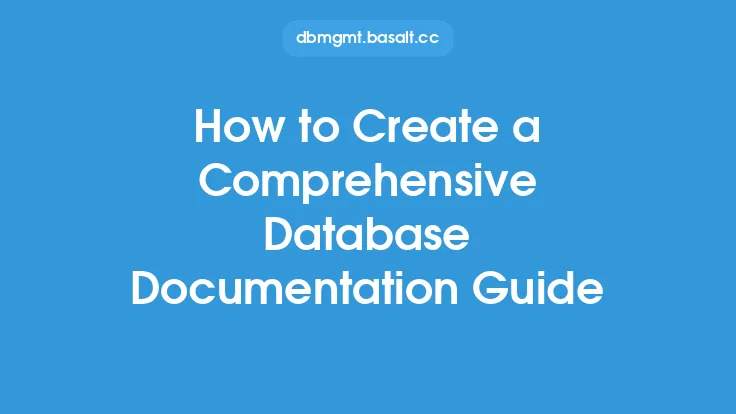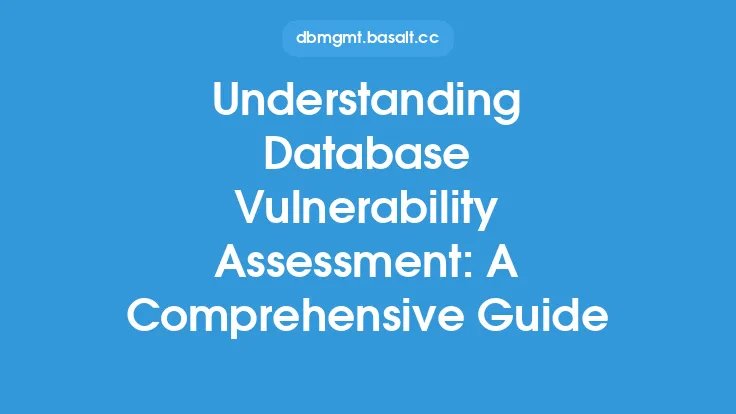Database auditing is a critical component of database administration that involves monitoring and tracking all interactions with a database, including data access, modifications, and other activities. This process helps to ensure the integrity, security, and performance of the database by providing a clear picture of who is accessing the data, what actions they are performing, and when these actions are taking place. In this article, we will delve into the world of database auditing, exploring its concepts, benefits, and technical aspects.
Introduction to Database Auditing Concepts
Database auditing involves the collection and analysis of audit logs, which are records of all database activities. These logs can include information such as the user who performed the action, the type of action (e.g., select, insert, update, delete), the timestamp of the action, and the specific data that was accessed or modified. The primary goal of database auditing is to provide a clear and detailed picture of all database activities, allowing administrators to identify potential security threats, troubleshoot performance issues, and ensure compliance with regulatory requirements.
Types of Database Auditing
There are several types of database auditing, each with its own specific focus and goals. These include:
- Object-level auditing: This type of auditing focuses on specific database objects, such as tables, views, or stored procedures. It tracks all actions performed on these objects, providing detailed information about who accessed or modified the data.
- Statement-level auditing: This type of auditing tracks all SQL statements executed against the database, including select, insert, update, and delete statements. It provides a comprehensive picture of all database activities, allowing administrators to identify potential security threats.
- Privilege-level auditing: This type of auditing focuses on the privileges and permissions assigned to database users. It tracks all actions performed by users with specific privileges, ensuring that users are not abusing their privileges.
Benefits of Database Auditing
Database auditing provides numerous benefits, including:
- Improved security: By tracking all database activities, administrators can identify potential security threats and take proactive measures to prevent them.
- Enhanced compliance: Database auditing helps organizations comply with regulatory requirements, such as HIPAA, PCI-DSS, and GDPR, by providing a clear and detailed picture of all database activities.
- Better performance: By analyzing audit logs, administrators can identify performance bottlenecks and optimize database performance.
- Data integrity: Database auditing helps ensure the integrity of the data by tracking all modifications and access to the data.
Technical Aspects of Database Auditing
From a technical perspective, database auditing involves the use of various tools and techniques to collect and analyze audit logs. These include:
- Audit log analysis: This involves analyzing the audit logs to identify potential security threats, performance issues, and compliance risks.
- SQL tracing: This involves tracing all SQL statements executed against the database, providing a comprehensive picture of all database activities.
- Database triggers: These are specialized procedures that are triggered by specific database events, such as insert, update, or delete statements. They can be used to collect and analyze audit logs.
- Auditing frameworks: These are specialized frameworks that provide a structured approach to database auditing, including tools and techniques for collecting and analyzing audit logs.
Database Auditing and Database Management Systems
Different database management systems (DBMS) have different auditing capabilities and requirements. For example:
- Oracle Database: Oracle provides a comprehensive auditing framework, including tools and techniques for collecting and analyzing audit logs.
- Microsoft SQL Server: SQL Server provides a range of auditing tools and techniques, including SQL Server Audit and SQL Server Profiler.
- MySQL: MySQL provides a basic auditing framework, including tools and techniques for collecting and analyzing audit logs.
Challenges and Limitations of Database Auditing
While database auditing provides numerous benefits, it also presents several challenges and limitations, including:
- Performance overhead: Database auditing can impose a significant performance overhead, particularly if the auditing is not properly configured.
- Data volume: The volume of audit data can be overwhelming, making it difficult to analyze and interpret.
- Complexity: Database auditing can be complex, particularly in large and distributed databases.
- Cost: Database auditing can be costly, particularly if specialized tools and techniques are required.
Best Practices for Database Auditing
To get the most out of database auditing, it is essential to follow best practices, including:
- Develop a clear auditing strategy: This involves identifying the goals and objectives of the auditing, as well as the types of activities to be audited.
- Configure auditing properly: This involves configuring the auditing tools and techniques to collect and analyze the required data.
- Monitor and analyze audit logs: This involves regularly monitoring and analyzing the audit logs to identify potential security threats, performance issues, and compliance risks.
- Test and refine the auditing: This involves testing and refining the auditing to ensure that it is effective and efficient.





